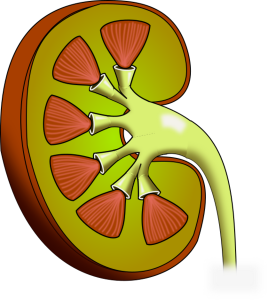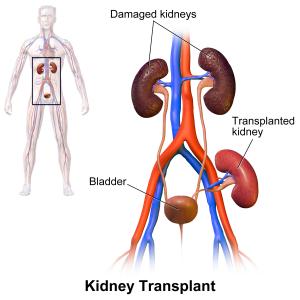First, if you are looking for information and registration info for our LIVE “Decade with Dave” Healthy Matters broadcast and the Here 4 Life health education series, click here.
April is Donate Life month. It is a time to reflect on the gift so many people have given by donating their organs to a person in need. At Hennepin Healthcare, we have a tremendous kidney donation program so I asked two key people from the transplant program to join me in the WCCO studio to talk about kidney disease and kidney transplant. I found much to learn! I hope to share some of what we learned here.
At the very end of this post I have a link to a story that should inspire you – the story of a brother and sister whose lives changed forever in 1975 through transplant. And who are still going strong today. Click on the link to read that story when you get to it.
To listen to the audio podcast of any Healthy Matters broadcast (free of commercials!) click on the banner here. The kidney show is Healthy Matters show #484, April 22,2018.
A few facts of kidney transplant in the United States (from Donate Life America):
- There are 100,000 people in the United States waiting for a kidney transplant
- The average wait time for a deceased donor kidney is 3-5 years
- People want to help: 95% of people are in favor of being a donor but only 56% are registered to be a donor
Inside a kidney transplant program
My expert guests on the show were Dr. Paul Stahler and Jenny Bodner from Hennepin Healthcare’s Kidney Transplant program. Dr. Stahler is a transplant surgeon and Jenny is a registered nurse by training who is the Living Donor Coordinator.
Here’s a condensed version of what they taught us on the show (with time marks for the audio podcast) . . .
Common causes of kidney failure (9:55 on the podcast)
The most common causes of kidney disease are high blood pressure and diabetes. Other causes include autoimmune diseases, medications, among others. I won’t get into the causes much since we wanted to focus on transplant. But if you are interested in learning more about these two causes, check out my previous writings at these links:
- Basics about blood pressure in this Pearls from Medical Science post from 2016
- Quick tips, including blood pressure
- New blood pressure guidelines from late 2017
- The basics of diabetes and more at this post from a couple years ago.
Dialysis vs kidney transplant (14:28 on the podcast)
You may not know everything the kidney does for you. Here is a partial list of functions handled by your kidneys:
- Regulation of body fluid levels so that the fluid in your bloodstream is adequate.
- Keeps your body fluids at the right concentration. Not too dilute, not too concentrated (sort of like coffee – not too strong, not too weak)
- Regulates the electrically charged ions in your bloodstream (like potassium, calcium, sodium).
- Filters and eliminates wastes and toxins through the urine.
- Keeps the acidity of your blood in the narrowly acceptable range for life (between 7.35 and 7.45. Anything outside this tight range is not normal).
- Produces vital hormones such as erythropoietin (essential for making new red blood cells) and renin (for regulating salt, water, and blood pressure)
That’s quite a job description for your beans. Beans – get it? As in kidney beans? A bit of dorky doctor humor.
Since you can’t live without these functions, even for a little while, your kidneys are super important. When they fail you really have two choices: dialysis or transplant. Dialysis, whether hemodialysis (using the blood stream) or peritoneal (using the abdominal cavity), carries out the functions of the kidney pretty well. Dialysis has been done for decades and has been responsible for improving and extending lives for that whole time. So hat’s off to dialysis.
But dialysis is an imperfect replacement for the miraculous, 24-hour a day work your kidneys do.
Fortunately, a human can easily get by with a single kidney. And it turns out – hey, we are born with two of them! At least most of us are. That simple truth means that a) you can have somebody else’s kidney implanted in your body, and b) you can do without one of your kidneys. Voila! Kidney donation and transplant.
Transplant is better (15:10 on the podcast)
Learn this truth: kidney transplant is better in the long-term than is dialysis and transplant is the better choice for most people with kidney disease.
There is evidence in the medical world for this, I’m not making it up. Quality of life is better with transplant and people live longer with transplant than with dialysis.
Jenny and Dr. Stahler work in the upper Midwest’s oldest kidney transplant program. That’s right, Hennepin Healthcare (HCMC) did the first kidney transplant in the upper Midwest in February 1963. Did you know that? And we’re still doing kidney transplants, 55 years later! In addition to that first transplant, Hennepin did this:
- Performed the first in the region living donor laparoscopic donor nephrectomy (removal of the kidney) in 1998.
- Performed the first paired exchange transplant in the region in 2010.
- Performs 75% of transplants in Midwest Native Americans
Check out more about the Hennepin Healthcare Transplant Program here.
Living donation (26:15 on the podcast)
Kidney donations can come from cadavers (deceased people), living donors, or unrelated living donors. Currently, about 2/3 still come from deceased donors and 1/3 are from living donors. By the way, please make sure you have told your loved ones that if the situation does arise that you want your kidneys to be collected and donated after your death. That is a true gift to someone whom you will never meet.
But let’s face it – there are not and will never be enough kidneys from people who die.
So living donation is essential. Rest assured, you can live just fine with one kidney. In fact, we learned on the show that people who donate a kidney often live longer than other people. This is probably because we only select donors who are super-duper healthy to begin with. The point is, removing one of the two kidneys from a healthy donor does NOT adversely affect that donor’s life. Listen to the podcast at about minute 28:42 for Dr. Stahler’s discussion about the safety of donation. We also learned that donors have really no limitations to their lifestyle following donation.
Jenny Bodner taught us that living donors get matched based on their blood type (A, B, AB, and O). After the blood type compatibility is determined, then donors are matched on their tissue type. This is determining whether the recipient’s immune system will accept or reject the new kidney.
Where does the new kidney go?
Since I had a transplant surgeon in the studio, I asked him to explain the process. It’s not exactly like most of us have ever been in the operating room. I asked him about how they remove the kidney from the donor. And I asked him a simple but common questions: where do they put the kidney in the recipient (it’s probably not where you think). Listen to his answers in the podcast at 30:15.
Here’s a picture of where they put the transplanted kidney:
For the rest of our transplant show, we talked about practicalities. How to become a donor, who do you call. when should you call. Give the podcast a listen for more.
Here’s my take home message: kidney donation is a gift of life. Pure and simple.
Thanks for reading this post and becoming more aware about transplant and donation! Thanks to Jenny Bodner and Dr. Paul Stahler for lending their expertise on a Sunday morning.
Click on the Hennepin Healthcare Kidney Transplant Program for LOTS more information.
I’ll close with a story of true inspiration. To celebrate Donate Life month, Hennepin Healthcare recently did a flag raising ceremony to which we invited Kris Roberts and John Nelson. Kris and John are siblings and in 1975 John received a kidney transplant from his sister, Kris. That was 42 years ago and Kris and John are both doing just great. They were on-hand at the flag raising this month. Read their inspiring story here.
-David
Haven’t subscribed by e-mail yet? Do so below or at the top. It’s easy!





